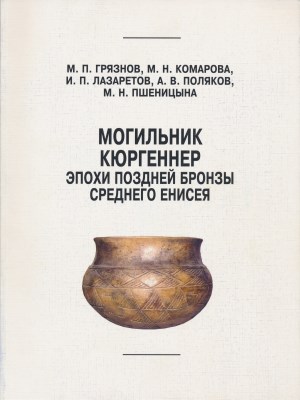 М.П. Грязнов, М.Н. Комарова,
М.П. Грязнов, М.Н. Комарова,
И.П. Лазаретов, А.В. Поляков, М.Н. Пшеницына
Могильник Кюргеннер
эпохи поздней бронзы Среднего Енисея.
// СПб: «Петербургское востоковедение»: 2010. 200 с. ISBN 978-5-85803-427-8
(Archaeologica petropolitana; Труды ИИМК РАН. Т. XXXI).
Под общей редакцией М.Н. Пшеницыной.
[ аннотация: ] Книга представляет собой коллективную монографию, основанную на материалах раскопок могильника Кюргеннер (126 курганов). Исследование этого памятника проводилось М.П. Грязновым и М.Н. Комаровой в процессе работ Красноярской экспедиции ЛОИА АН СССР в 1965-1966 гг. Были получены ценные и в ряде случаев уникальные материалы, датируемые классическим этапом карасукской культуры. Они сразу поступили на постоянное хранение в фонды Государственного Эрмитажа, но, в силу ряда обстоятельств, не зависящих от авторов раскопок, до сих пор не были введены в научный оборот.
В первой главе представлены материалы могильника, а также некоторые предварительные выводы М.П. Грязнова, содержащиеся в его полевых отчётах и отдельных кратких публикациях. Остальные четыре главы, написанные А.В. Поляковым и И.П. Лазаретовым, посвящены исследованию этого памятника и определению его места в рамках современных представлений об относительной хронологии эпохи поздней бронзы на Среднем Енисее. К монографии приложена работа С.В. Хаврина, в которой рассматривается вопрос о химическом составе бронзовых изделий могильника.
Монография представляет большой интерес для археологов, антропологов, этнографов, историков и краеведов.
На первой странице обложки: глиняный сосуд (Кюргеннер I, курган 2, могила 2).
См. файл на academia.edu.
Оглавление
Предисловие. М.Н. Пшеницына. — 6
Глава I. М.П. Грязнов, М.Н. Комарова, М.Н. Пшеницына. Материалы могильников Кюргеннер I и II. — 9
Кюргеннер I. — 18
Кюргеннер II. — 37
Глава II. А.В. Поляков. Общая характеристика материалов могильников Кюргеннер I и II. — 43
Глава III. А.В. Поляков. Относительная хронология погребений могильника. — 60
Глава IV. А.В. Поляков. Типология керамики из погребений классического этапа карасукской культуры. — 70
Глава V. И.П. Лазаретов. Группа атипичных погребений могильника Кюргеннер I. — 83
Приложение I. М.Н. Пшеницына, А.В. Поляков. Архивные материалы. — 95
Приложение II. А.В. Поляков. Статистические данные. — 97
Приложение III. С.В. Хаврин. Металл могильника Кюргеннер. — 102
Иллюстрации. — 107
Список литературы. — 192
Список сокращений. — 196
Summary. ^
This volume represents a collective monograph, based on the materials of the Kyurghenner cemetery, situated on the Middle Yenisei in the northern part of the Minusinsk depression (Republic of Khakassia, Russian Federation). The site was studied by M.P. Gryaznov and M.N. Komarova in the course of the salvation excavations carried out by the Krasnoyarsk Expedition of the Leningrad Branch of the Institute of Archaeology in the flooding area of the Krasnoyarsk water power plant in 1965-1966. In two years the researchers studied 126 barrows and obtained valuable and in some instances unique materials, dated to the “classical” stage of the Karasuk culture (Late Bronze Age, XIII-XI cc. BC). They were immediately passed for storage to the State Hermitage, but due to various circumstances, which did not depend on the excavators’ will, remained unpublished. The present volume contains both the description of the evidence obtained during the field works and detailed analysis of these materials. It consists of five chapters and three appendixes.
The first chapter is based on M.P. Gryaznov’s and M.N. Komarova’s field reports, and on field notes taken by the participants of the expedition. In addition, it presents some of Gryaznov’s preliminary conclusions contained in his reports and brief publications. The illustrations include all the available plans and sections of the cemetery, as well as numerous drawings of finds stored in the Hermitage.
Three next chapters are written by A.V. Polyakov. They are devoted to the thorough analysis of the site. Chapter 2 gives a careful consideration of the complex of traits associated with the funerary rite. The analogies are sought for both within the Karasuk culture itself and among the Late Bronze Age sites of the adjacent regions. The chapter is concluded with the general characteristic of the cemetery materials. Chapter 3 is devoted to the position the cemetery within the frameworks of the current views on the relative chronology of the Late Bronze Age in the Middle Yenisei region. The example of Kyurghenner is used to illustrate the existence of two independent chronological horizons within the limits of the “classical” stage of the Karasuk culture. A new typology of the pottery coming from the burials of this stage is proposed in chapter 4.
Chapter 5, written by I.P. Lazaretov, is devoted to the study of the group of atypical interments of Kyurghenner. The author offers a new vision of the process of formation of the later Kamennyi Log stage of the Karasuk culture. The appendixes include the list of the archive sources used by the authors, statistical tables, and the work by S.V. Khavrin, who analyzed the chemical composition of the bronze artifacts from Kyurghenner.
The monograph is intended for archaeologists, physical anthropologists, and ethnographers, but can also be of interest for numerous amateurs of history.
|